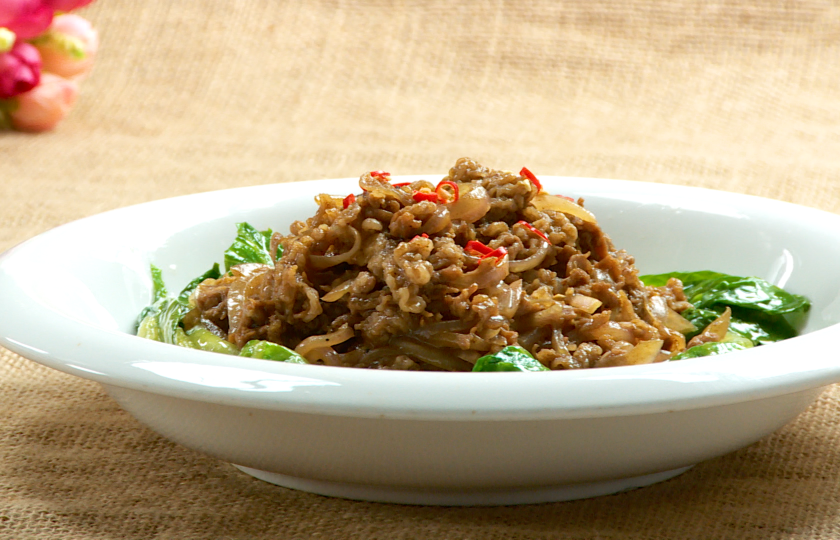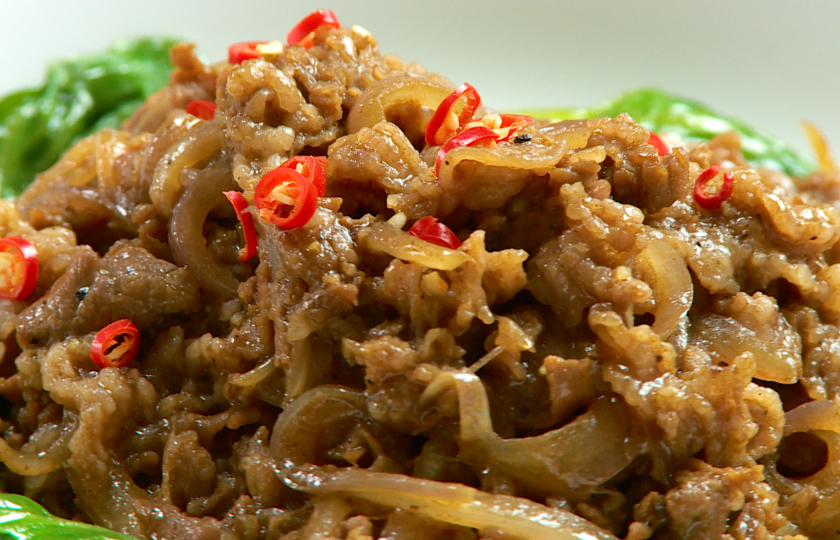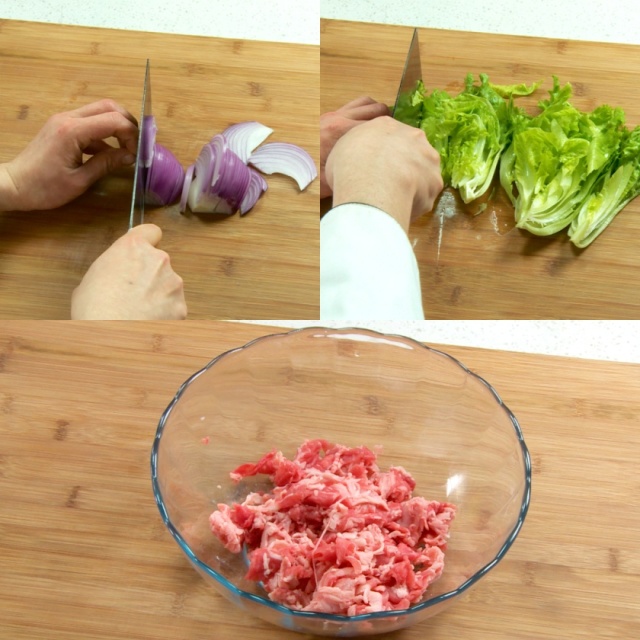Beef in Oyster Sauce Recipe for Beginners


Delicious food always makes people think of many things. This oyster sauce beef is a treasure that can open the door to memories for me.
I remember when I was a child, as long as I ate this dish, I would be very happy. Now I share this recipe full of memories. I hope that when you make and eat this dish, you can also find those memories of your own past.
What kind of dish is oyster sauce beef
Beef is the main ingredient. The tender taste is the key to this dish. Through marinating and quick stir-frying techniques, the tenderness of beef can be preserved to the greatest extent.
Oyster sauce is the soul seasoning of this dish. The unique umami taste of oyster sauce endows beef with a rich and mellow flavor and enhances its umami taste. Combined with the sweetness of onions and the freshness of lettuce, it forms a rich combination of flavors.
Onions add sweetness to beef during the marinating process and release a unique fragrance when stir-fried.
After blanching, lettuce has a soft and fresh taste. Laying it at the bottom of the plate can not only absorb the soup of beef but also add a refreshing taste to the rich beef, making its overall flavor more balanced.
The addition of black pepper adds a hint of spiciness to the dish, making the taste more rich and three-dimensional.

Ingredients and substitutes
To make this oyster sauce beef, you need to prepare the following materials:
Main ingredients
Fatty beef rolls: The meat is tender and juicy. It is the main source of protein for the dish and provides the mellow flavor of beef.
Onions: After being shredded, it can not only add flavor to the fatty beef rolls during marinating but also has a unique sweetness and aroma after stir-frying, enriching the taste of the dish.
Lettuce: After blanching, it has a refreshing taste and can be used as a bedding for the dish to neutralize the greasiness of fatty beef rolls.
Accessories
Red pepper rings: Mainly play a role in decoration. At the same time, it can also add a little bit of spicy visual and taste layers to the dish.
Seasonings
Light soy sauce: Adds salty and fresh taste to make fatty beef rolls more flavorful.
Cooking wine: Used to remove fishy smell and greasiness and improve the taste of fatty beef rolls.
Oyster sauce: It is the key seasoning for this dish and gives the dish a rich umami taste.
Salt: Controls the overall saltiness and plays a role in different steps such as blanching lettuce and marinating fatty beef rolls to make the dish taste appropriate.
Dark soy sauce: Mainly used for coloring to make the color of fatty beef rolls more attractive.
Black pepper: Adds a slight spicy taste and enriches the taste layers of the dish, playing a role in removing fishy smell and enhancing freshness.
Oil: Meets the need for oil in steps such as stir-frying fatty beef rolls, so that the ingredients are heated evenly and add fragrance.
Hot water: Used for blanching lettuce to ensure that lettuce can be cooked quickly and maintain a certain taste.
Starch water: Used for thickening and reducing the sauce so that the soup becomes thick and can better wrap on the fatty beef rolls and lock in the taste.
Substitutes
Fatty beef rolls: Can be replaced by fresh beef tenderloin cut into thin slices. Beef tenderloin is tender. After being cut into thin slices, it can imitate the taste of fatty beef rolls to a certain extent.
Onions: Can be replaced by scallions. Scallions have a strong scallion fragrance and can add similar fragrance to the dish.
Lettuce: Can be replaced by pakchoi. Pakchoi has a tender taste and can also play a role in relieving greasiness.
Red pepper rings: Can be replaced by dried chili flakes. Dried chili flakes can better release spiciness during cooking and add spicy layers to the dish.
Light soy sauce: Can be replaced by very fresh soy sauce. Very fresh soy sauce can also add salty and fresh taste to the dish.
Cooking wine: Can be replaced by yellow rice wine. Yellow rice wine has a strong wine fragrance and can play a role in removing fishy smell and greasiness.
Oyster sauce: Can be replaced by shrimp paste. Shrimp paste has a rich umami taste and can add a unique flavor to the dish.
Dark soy sauce: Can be replaced by braised soy sauce. Braised soy sauce can also play a role in coloring.
Black pepper: Can be replaced by white pepper. White pepper can also add spicy taste and play a role in removing fishy smell and enhancing freshness.
Starch water: Can be replaced by lotus root starch. Lotus root starch can also make the soup become thick.
The magical effect of oyster sauce
Its excellent ability to enhance freshness is second to none. Oyster sauce, which is made from boiled oysters, is rich in umami ingredients such as amino acids. It can deeply stimulate the umami taste of beef itself and greatly increase the deliciousness of beef. With the enhancement of oyster sauce, even without many cooking techniques and many umami seasonings, beef can release a rich and mellow fresh taste. Every bite is full of attractive freshness.
The addition of unique flavor should not be underestimated. The complex flavor of oyster sauce with intertwined salty and sweet gives beef a new taste dimension. It blends with the mellow meaty fragrance of beef. When stir-fried, it gives birth to a unique rich aroma. Compared with simple salt and sugar seasoning, this taste is more diverse and charming. At the same time, oyster sauce can also cleverly cover up the potential fishy smell of beef, making the meaty fragrance more pure and the flavor more harmonious and beautiful.
Furthermore, oyster sauce plays a significant role in shaping color. The color of oyster sauce is relatively dark. During the stir-frying process, it can help beef color better. Especially before adding dark soy sauce for coloring, oyster sauce has already started to make the color of beef more attractive, making it more visually appealing and increasing the appetite of diners.
Professional tips
The selection and processing of beef are crucial. You should choose fresh beef tenderloin or beef shoulder meat with clear texture and cut it into thin slices for easy seasoning and quick stir-frying.
After cutting, use kitchen paper towels to absorb moisture to prevent excessive water from coming out during marinating and stir-frying.
In the marinating process, the seasonings should be fully mixed with beef. You can massage moderately. You can also add a little baking soda to increase the tenderness, but the amount should not be too much.
Marinating for 10 - 15 minutes is enough. Too long a time will cause beef to release water and lose elasticity.
During the stir-frying process, heat the pan first and then pour oil. After the oil is hot, add beef. Keep the heat on medium-high and quickly stir-fry until the color changes and then take it out to prevent it from becoming old and hard. The subsequent stir-frying time with seasonings should not be too long.
For lettuce processing, when blanching, there should be enough water and cook quickly over high heat. Adding salt and oil can maintain its green and crisp tenderness.
The time needs to be accurately grasped. Too long a time will cause lettuce to lose color and crispness. After taking it out, be sure to drain the water thoroughly, otherwise it will dilute the taste of the dish. Following these points can you cook delicious oyster sauce beef with excellent color, aroma and taste.
INGREDIENTS
Main Ingredients
-
·400g fatty beef rolls
-
·1 onion
-
·1 lettuce
Additional Ingredients
-
·5g red pepper rings
Seasonings
-
·20ml light soy sauce
-
·15ml cooking wine
-
·30ml oyster sauce
-
·8g salt
-
·5ml dark soy sauce
-
·3g black pepper
-
·20ml oil
-
·500ml hot water
-
·5ml starch water
COOKING STEP
Step 1
Cut the onion into thin shreds. After removing the roots of the lettuce, cut it into strips. Take out the beef rolls and set them aside.

Step 2
Mix the onion shreds with the beef rolls. Pour in 20 milliliters of light soy sauce, 15 milliliters of cooking wine and 15 milliliters of oyster sauce in turn. Stir carefully and evenly to make each piece of beef roll coated with seasonings. Marinate for 10 minutes to allow it to fully absorb the flavors.

Step 3
Pour 500 milliliters of hot water into the pot. Add 4 grams of salt and 15 milliliters of oil. Heat the water over high heat until it boils. Quickly put in the lettuce strips and blanch for about 1 minute and 30 seconds. After the lettuce becomes soft, take it out in time and drain the water.

Step 4
Heat 10 milliliters of oil in another pot. Heat over medium heat patiently until the oil smokes slightly. Put in the marinated beef rolls and stir-fry quickly until the beef changes color.

Step 5
Add 15 milliliters of oyster sauce and stir-fry briefly for fusion. Then pour in 5 milliliters of dark soy sauce to instantly give the beef rolls an attractive color. Sprinkle 1.5 grams of black pepper and stir-fry for about 2 minutes to let the fragrance deeply penetrate.

Step 6
Slowly add 5 milliliters of water starch to the pot and stir quickly for several times. The originally thin soup immediately becomes thick.

Step 7
First evenly spread the blanched lettuce on a plate. Then pour in the fried beef rolls. Finally, sprinkle red pepper rings for decoration. It is completed.

More recipes worth trying
Jade Tofu(Tofu with Vegetables)
Tofu With Ground Pork Oyster Sauce Chinese
Recipe Variations
Bell pepper and oyster sauce beef cubes:
Cut the beef into small cubes and stir-fry it with shredded onions and red, yellow and green bell pepper cubes. Bell peppers not only add rich colors, but also their sweet taste sets off the deliciousness of beef, making the dish more refreshing and appetizing. Moreover, it is rich in nutrients such as vitamin C, enhancing both vision and nutrition.
Mushroom and oyster sauce beef casserole:
After stir-frying the beef until fragrant, add soaked and sliced mushrooms and stir-fry together. Then transfer it to a casserole, add an appropriate amount of clear water or stock, and simmer over low heat. The unique aroma of mushrooms is integrated into the beef, making the beef become more tender and juicy, and the soup is rich and mellow. It is suitable for the whole family to share in winter, warming and delicious.
Black pepper and oyster sauce beef pasta:
Combine oyster sauce beef with cooked pasta. Add crushed black pepper when stir-frying beef, mix it evenly with pasta after stir-frying until fragrant, and then sprinkle with cheese powder. This combination of Chinese and Western styles gives traditional oyster sauce beef a new presentation form. The chewy texture of pasta and the tenderness of beef collide with a different flavor under the seasoning of black pepper and oyster sauce, which is deeply loved by young people.
FAQs:
The size of the pan cannot be ignored and should be moderate. If it is too small, beef slices are likely to pile up and be heated unevenly, with some parts being overcooked and some parts being undercooked. A proper size allows beef slices to be spread flat in the pan for easy stir-frying.
Furthermore, the bottom of the pan should be flat. If it is not flat, oil and juice will gather in low-lying areas, causing beef to be partially immersed in liquid, which not only affects the taste and appearance but also is not conducive to the even conduction of heat. In short, choosing the right pan plays a key role in stir-frying delicious and tender oyster sauce beef.
In terms of cooking time, high heat can make beef quickly heated in a short time. Beef contains moisture and protein. Stir-frying over low heat for a long time is likely to cause moisture to be lost, resulting in a dry and tough taste. Stir-frying quickly over high heat can cook beef before a large amount of moisture is lost, retaining a tender taste.
From the perspective of cooking principles, high heat can quickly lock in the juice of beef. When beef comes into contact with the high-temperature bottom of the pan and hot oil, the surface protein quickly denatures and forms a protective film to prevent the internal juice from flowing out. For tender meat parts like beef tenderloin, stir-fry quickly over high heat for a few minutes. Once the surface changes color, it can be taken out. The finished product is tender and juicy.
However, it should be noted that during stir-frying over high heat, it is necessary to stir quickly to ensure that all sides of beef are evenly heated. Otherwise, local overheating and scorching are likely to occur, affecting the quality and taste of the dish. Mastering the skill of quick stir-frying over high heat is one of the key points for stir-frying delicious beef.
During the subsequent stir-frying, adding 10 to 15 milliliters of oyster sauce can enhance the umami taste of the whole dish and make beef and side dishes such as onions coated with the delicious taste of oyster sauce. However, if a relatively large amount of other umami seasonings such as light soy sauce and fish sauce have been used, less oyster sauce should be added, otherwise the taste is likely to be too heavy.
For people who dont like too strong umami taste, the amount of oyster sauce should also be appropriately reduced. Only in this way can one find the best balance that suits ones own taste and make oyster sauce beef that is both delicious and to ones liking.
Beef shoulder (blade steak): Beef shoulder is also a good choice. Its meat is tender and juicy, and there is a transparent tender tendon in the middle. This tender tendon will increase the toughness and chewiness of the taste after cooking, but it will not be too hard. Its fat content is moderate. During marinating and stir-frying, it can better absorb the flavors of seasonings such as oyster sauce, making the beef taste more intense and having rich taste layers.
Beef sirloin: Beef sirloin is relatively tender, with little fat and loose meat fibers. Such a meat structure makes it able to quickly absorb seasonings during stir-frying and be easily cooked. The stir-fried beef is tender and not lacking in chewiness. Paired with oyster sauce, it also tastes very good.

















